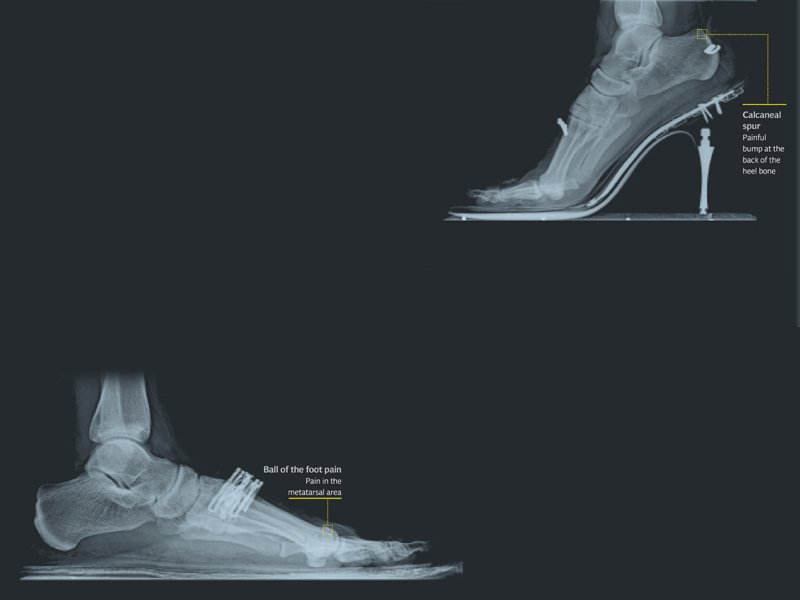
Orthopedic surgeon Dr Abdul Haseeb Qureshi explains that the trouble starts when you mess with the natural distribution of weight on your feet by wearing high heels. “Your forefoot and the heel are [then] not on an equal level which is important to transfer equal pressure from both legs onto the spine” he says.
As a result, too much pressure is put on the front of the foot, possibly leading to severe ankle, knee and spine sprains, as high heels throw off kilter the alignment of your hips, shoulders, back and spine.
Prolonged wear also leads to the formation of a painful bump at the back of the heel bone. “This is called a calcaneal spur, or heel spur,” says Qureshi. “It is common in European countries where women often wear high heels.”
Experts also warn that wearing high heels with narrow toes can thicken the nerves, as a result of which you can develop a lump on the underside of your foot.
In the long term, women who wear high heels will find their calf muscles become more rigid. “Since the calf muscles in your legs aren’t strong enough, they naturally contract when you wear high heels,” says Qureshi. They actually become shorter over time so when you do wear flats it is painful.
And while you may think that high heels flatter your silhouette, be prepared to suffer from calluses, corns and blisters when the heels throw your weight on to the ball of your foot.
Ironically, the kolhapuri chappal and khussa are not much better for your foot.
“Flat shoes don’t give you enough support,” says physical therapist Dr Usman Ghani, who has worked with the Pakistan cricket team. “Khussas have no arch support; they’re merely ‘cosmetic’ chappals that should not be worn when you’re on your feet for a long period of time.”
The lack of arch support and an inappropriately hard sole are the main causes of foot pain in the metatarsal area, the area just before the toes, explains Dr Ghani. “When you raise your heels, the toes go into extension mode and so the sole of the shoe needs to be flexible to allow this extension.”
Along with high heels, perfectly flat shoes also cause heel pain and tighten calf muscles. “This is commonly known as plantar fasciitis. It is essentially an irritation of the plantar fascia tissue, which runs along the bottom of the foot, connecting the heel to the arch,” says Dr Ghani. Thus doctors recommend that in many cases, two-inch heels can be healthier for your feet than flats.
Pregnant women are advised not to wear flats during their first trimester. Ballet pumps and flip flops are unsuitable for daily wear in pregnancy as they don’t provide your feet the necessary support. “During pregnancy it is preferable [for women] to wear low-heeled, comfortable shoes to tone up your back muscles,” explains Qureshi. They are ideal to wear till the time your baby bump starts exerting pressure on your back.
Published in The Express Tribune, Sunday Magazine, June 9th, 2013.
Like Express Tribune Magazine on Facebook, follow @ETribuneMag on Twitter to stay informed and join the conversation.
COMMENTS (4)
Comments are moderated and generally will be posted if they are on-topic and not abusive.
For more information, please see our Comments FAQ




1719660634-1/BeFunky-collage-nicole-(1)1719660634-1-165x106.webp)

1729930993-0/WhatsApp-Image-2024-10-26-at-08-52-06-(2)1729930993-0-270x192.webp)










There are ways to wear high heels and protect your feet. Plus one key factor is to wear a variety of heel heights — that keeps the flexibility in your feet. And it is very important to get podiatric checkups. Prescription orthotics can go a long way to help correct weight distribution and give support to your feet where they need it. Please check out the link: http://santamonicapodiatry.com/proper-foot-care/shoeicide-fact-or-fiction/
In case you didn't notice Brett, throughout the piece i've mentioned either "prolonged wear" or "constant wearing." As any doctor would advice you, 'moderation' is the way to go about it.
This article is full of inaccuracies. If the orthopedic surgeon quoted approved this, I'm not sure he is an authority. I see no recommendation in this article that is based on clinical evidence.
I've sent this to my daughter, who'll read it and laugh ................ then say ' you only live once '.